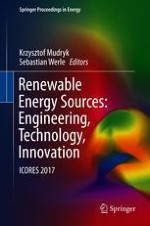2018 | OriginalPaper | Chapter
Increasing the Energy Efficiency of Hybrid RES Installations Using KNX System
Author : Sławomir Sowa
Published in: Renewable Energy Sources: Engineering, Technology, Innovation
Publisher: Springer International Publishing
Activate our intelligent search to find suitable subject content or patents.
Select sections of text to find matching patents with Artificial Intelligence. powered by
Select sections of text to find additional relevant content using AI-assisted search. powered by
